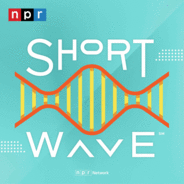The Dog Aging Project is a long-term nationwide survey on the health and lifestyles of U.S. dogs that launched in 2019. Today, the project has more than 50,000 canines and counting. Today, hear what researchers have learned from one of the largest dog health data sets and what it could tell us both about increasing the lifespan of our furry friends and us.For more information about signing your pup up for the Dog Aging Project, visit their website.Have more questions about animals? Let us know at shortwave@npr.org. Listen to every episode of Short Wave sponsor-free and support our work at NPR by signing up for Short Wave+ at plus.npr.org/shortwave.Learn more about sponsor message choices: podcastchoices.com/adchoicesNPR Privacy Policy

Wissenschaft & Technik
Short Wave Folgen
New discoveries, everyday mysteries, and the science behind the headlines — in just under 15 minutes. It's science for everyone, using a lot of creativity and a little humor. Join hosts Emily Kwong and Regina Barber for science on a different wavelength.If you're hooked, try Short Wave Plus. Your subscription supports the show and unlocks a sponsor-free feed. Learn more at plus.npr.org/shortwave
Folgen von Short Wave
1405 Folgen
-
Folge vom 09.06.2025Helping Dogs and Their Pawrents Live Healthier, Longer
-
Folge vom 06.06.2025Unveiling Olo — A Color Out of Oz!"Olo" does not exist in nature, nor can it be found among paint cans. But for a very select few, olo can be seen — through the intervention of careful computing and lasers. A team led by vision scientist Austin Roorda and computer scientist Ren Ng at UC Berkeley figured out a method for stimulating only one specific subset of cones of the retina. It's the only way to view this spectacular teal. Creating the color is helping push the boundaries of vision science.Follow Short Wave on Spotify, and Apple Podcasts.More questions about the science behind our everyday lives? Email us at shortwave@npr.org. Learn more about sponsor message choices: podcastchoices.com/adchoicesNPR Privacy Policy
-
Folge vom 04.06.2025Anglerfish Ancestors Once Roamed The SeafloorThere are over 200 species of deep-sea anglerfish; some are long and thin, some are squat and round, some have fins that they use to "walk" along the sea floor, and others have huge eyes set far back into their heads. But how did all this morphological diversity first come to be? Thanks to a new anglerfish family tree, now we know. Scientists built this evolutionary tree using genetic information from hundreds of samples and anglerfish specimens across the globe. It indicates that anglerfish originated from an ancestor that crawled along the seafloor ... and sheds new light on how experts could think about biodiversity as a whole.Learn more about sponsor message choices: podcastchoices.com/adchoicesNPR Privacy Policy
-
Folge vom 03.06.2025Can AI Crack The Biology Code?As artificial intelligence seeps into some realms of society, it rushes into others. One area it's making a big difference is protein science — as in the "building blocks of life," proteins! Producer Berly McCoy talks to host Emily Kwong about the newest advance in protein science: AlphaFold3, an AI program from Google DeepMind. Plus, they talk about the wider field of AI protein science and why researchers hope it will solve a range of problems, from disease to the climate.Have other aspects of AI you want us to cover? Email us at shortwave@npr.org.Learn more about sponsor message choices: podcastchoices.com/adchoicesNPR Privacy Policy
